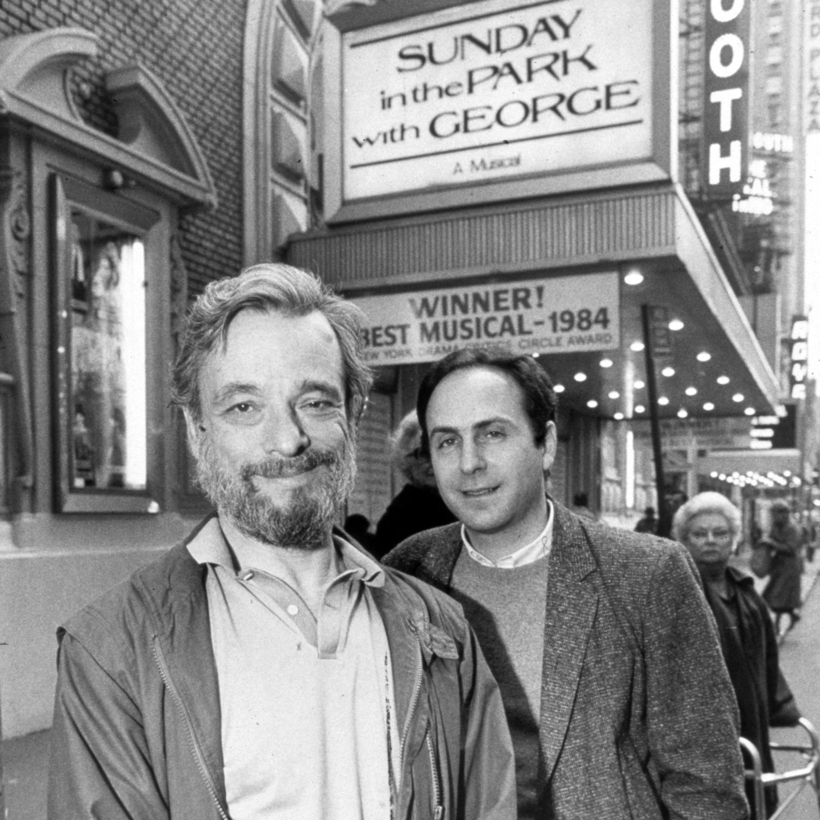On a June afternoon in 1982, fledgling playwright James Lapine sat nervously on a sofa in Stephen Sondheim’s Manhattan town house. The composer promptly lit a joint and passed it to his visitor, and an improbable partnership was born.
“I just figured that anybody of your generation smoked dope all the time, which was true,” Sondheim tells Lapine, nearly 20 years his junior, in Putting It Together. Part memoir, part oral history, part Baedeker guide, this captivating new book chronicles Lapine and Sondheim’s two-year odyssey to create the 1983 hit musical Sunday in the Park with George.
Lapine was inspired to revisit this collaboration while watching the 2017 revival of the play starring Jake Gyllenhaal. “After about 20 minutes or so,” he explains in the introduction, “a voice came in my head, Who wrote this particular musical? Who were Sondheim and I in 1982, when we embarked on this project?”
To supplement his own “complicated and occasionally painful” memories of writing and directing the show on and off Broadway, Lapine interviewed more than 40 surviving members of the original cast and creative team, including Sondheim, who is now 91. The result is an unvarnished, affectionate history.
Picture This
From the first, Sunday in the Park with George was audacious: a new musical inspired by a painting by 19th-century French artist Georges Seurat, who died young. This blank canvas, as it were, provided fertile ground for a story about the pointillist painter’s imagined struggles to finish his masterpiece.
To those familiar with the breadth of Sondheim’s career, it seems impossible that he was at such “a dark place” when he and Lapine met, six months after Merrily We Roll Along flopped on Broadway. “I thought, I don’t want to be in this profession; it’s just too hostile and mean-spirited,” he tells Lapine in the book. “What else can I do?”

But then Sondheim saw Lapine’s 1981 play, Twelve Dreams, based on one of psychiatrist Carl Jung’s case studies, and arranged for the two to meet. Lapine had seen only one of Sondheim’s shows, Sweeney Todd. Their partnership eventually birthed not only Sunday in the Park with George but also the genre-bending Into the Woods and the beloved Passion.
Sondheim promptly lit a joint and passed it to Lapine, and an improbable partnership was born.
There were times when Lapine doubted Sondheim would ever finish the score. Putting It Together is nostalgic about the unconventional process between stage director and composer, one unlikely to survive today’s instantaneous social-media reviews and the stark realities of Broadway economics.
The first act of Sunday in the Park with George was workshopped in a public run at the Playwrights Horizons theater, in New York, and Broadway previews began with several placeholder monologues in the second act instead of songs. The musical’s alums provide a raw look at the missteps of an untried director working on an unfinished show.
Brent Spiner fumed when Lapine told him, “You’re not a character, you’re a color.” Bernadette Peters was concerned that the mechanical dress she wore would malfunction (it did), and several actors chime in on Lapine’s lack of positive feedback. The more he “accepted the fact that everyone didn’t like me and moved on,” Lapine writes, “the better I got at my job.”
There were times when Lapine doubted Sondheim would ever finish the score.
After Mandy Patinkin threatened to quit during a workshop, Lapine consulted the star’s wife, the actress Kathryn Grody. Her advice? “Just tell him you love him.” Mellowed by the passage of time, Patinkin looks back at his tempestuous younger self with grace, and his conversations with Lapine are both revealing and moving.
While some moments about the more technical aspects of the production, such as orchestrations or lighting design, may be a bit granular, Lapine’s own enthusiasm and attention to detail shine. And it is that same sensibility to which the work itself pays homage. As Sondheim says, “This show is about our attitude toward art and artists and the difficulty of living.”
Still, Putting It Together highlights the bleak Broadway-preview period. Audience members left in droves at intermission. The crew took to calling it Sunday in the Dark and Bored. Producer Manny Azenberg confessed he didn’t care about the characters or like the show. The second act remained incomplete.

But, like Seurat’s masterpiece, Lapine asserts, Sunday in the Park with George slowly came together bit by bit, piece by piece, right up until its opening to the public on May 2, 1984. The final two songs in the show, “Children and Art” and “Lesson #8,” were added the night before the critics came. Lapine writes, “To this day, I am baffled about why it took Steve so long to deliver them.” The production went on to earn 10 Tony nominations and the 1985 Pulitzer Prize for Drama.
In the vein of Moss Hart’s Act One (which Lapine adapted for the stage), the playwright’s own reflections, presented chronologically, structure his compelling narrative. Putting It Together also features early drafts, handwritten lyric notes, previously unseen personal photos, and the full text of the show. It’s like eavesdropping on a conversation between legends, because, well, it is.
Now, 17 months after Broadway went dark, Putting It Together is a welcome testament to the endurance of art and beauty. As Lapine writes, “At the time, none of us could have been aware that Sunday in the Park with George would be a watershed event in our lives. We were too absorbed, inside our painting, putting it together.”
Asher Fogle Paul is an author and journalist. Her debut novel, Without a Hitch, will be published in December


